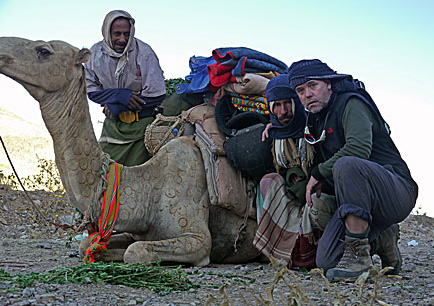
by Iona Craig, The National, January 9, 2012
A Swedish adventurer crossing Yemen by camel hopes his journey will encourage tourists to see beyond the political turmoil and violence that has engulfed the country for nearly a year.
Mikael Strandberg set out on December 7 on a 380-kilometre trek across the treacherous highlands, the first leg of his Yemen venture, to disprove the purveyors of pessimism.
“I don’t know what they [the tourists] are waiting for … it is such a wonderful country with great potential,” he said, after arriving in Sanaa after a two-week march through the toughest terrain in the Arabian Peninsula.
Along with two Yemeni companions, Mr Strandberg is in the initial phase of a journey that will cross the country from the western coastal plains of Hodeida to the edge of the world’s largest sand desert, the Rub’ Al Khali, or Empty Quarter, and beyond to Oman.
The explorer, 48, who fell in love with both the country and his wife Pamela, an American, during a visit to
Yemen three years ago, holds fond memories of Sanaa and the Yemeni people.
“We decided to go and try to make a difference and give a different perspective from the one portrayed by the media,” said Mr Strandberg.
Hundreds of protesters in Yemen’s cities have been killed since mass demonstrations demanding the resignation of the long-time president, Ali Abdullah Saleh, began last February.
While Mr Saleh signed a deal in November to hand over power to his vice president, the transition will not be complete until presidential elections next month.
The move has failed to completely end the violence between backers of Mr Saleh and his opponents. Mr Strandberg arrived in October, when mortar explosions and gunfire could be heard regularly in the capital. His most pressing challenge was finding a suitable camel to carry supplies, cooking and camping gear. Most are unaccustomed to travelling long distances, especially across the mountainous northern terrain. The animals are still a common sight in rural areas in Yemen.
“The camel had never been out of Tihamah before,” explained Mr Strandberg.
One of the oldest centres of civilisation in the Middle East, Yemen has attracted European explorers as far back as 18th century. Five Scandinavian and German scientists, along with a cavalryman, spent eight months from 1772 to 1773 in “Arabia Felix” (Happy Arabia) under the orders of the Danish and Norwegian King Frederik V, to make “as many discoveries for science as is possible”.
The renowned German cartographer, Carsten Niebuhr, created the first geographic diagrams of the southern Arabian Peninsula during the expedition. His work stood for 200 years as the basis for all other Yemen mapmakers.
Many of the country’s rural areas remain untouched and unseen by foreigners. Of all the 125 countries Mr Strandberg has visited during more than two decades of travel and exploration, he said Yemen was one of the unique places in the world.
Although the complete journey will take them through more remote areas, during the first stage from Hodeida to Sanaa, Mr Strandberg met people who had never seen foreigners before.
“The difficult points were when you realise people are really suffering,” said Mr Strandberg. “With no way to communicate, no water, no electricity, transport or education, and they crave education.”
Mr Strandberg, who works as a tour guide in South America and as a motivational speaker, said the highlight of his trip was his contact with the Yemeni people he met and the hospitality they offered.
“Everyone thinks Yemen is Sanaa, but it’s not. Every area, every tribe, is like is a new country. Different attitudes and different people. Every day we were surrounded by people who came to walk with us.”
Inspired by Mohammed Asad’s descriptions of the precious solitude of desert travel in his book The Road to Mecca, the next leg of Mr Strandberg’s journey – travelling east starting in March from Sanaa through Marib and on through the Arabian deserts of Hadhramaut towards the Omani border – will complete his dream of travelling across Yemen.
Follow Mr Strandberg’s journey on his blog here.